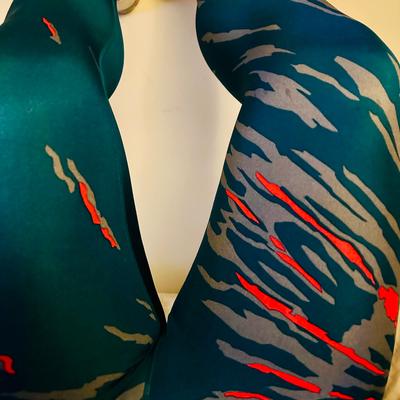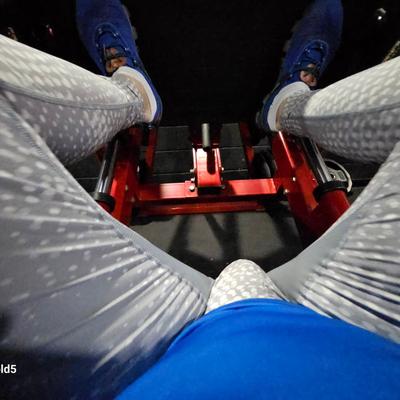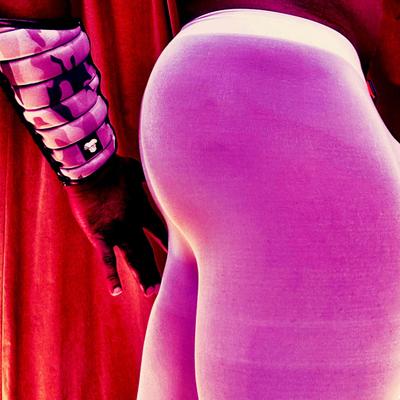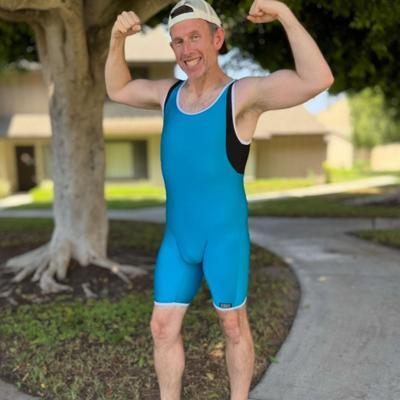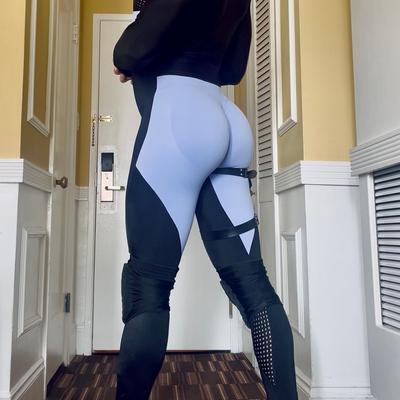posted by: unbtim
Over the years I have had tons of spandex from brands that I miss big time. One of the brands that I loved was called Hind. They made the most amazing spandex shorts. It was thick spandex that felt great working out. It's like the difference between a Speedo brand swim brief vs. one you just have fun on the beach. They were well made and were designed for working out. No other current brand comes close to what they did. Are there any brands you miss? If so what are they?
HIND!!! Yes! "Make it happen with HIND." That was their slogan printed on the original hangtags to their spandex when they were brand new hanging on the sporting goods store racks back in the day. And I'm proud to say that I still have these hangtags, and I still wear my original vintage Hind spandex to this day.
First, a little history lesson about Hind. The company we knew as Hind didn't originally start by making spandex athleticwear. Greg Hind was an accomplished water polo player who founded his company called GH Company, Inc., in 1966 to make ear guards for the sport of water polo, and during the '70s, his company produced other types of swim accessories. They finally ventured into spandex athletic apparel when they introduced their Water Polo Suit in 1977 and their 2-piece Competition Swimsuit for women in 1978.
In 1979, they introduced the first-ever fitness tights with their full-length "ST2" running tights, and they were something radically new at the time, not just in terms of looks and style, but because they were meant to be worn by both men and women. Unisex athleticwear for all! The tights used the same thicker-weight spandex as their swimsuits at the time. Here in the USA in the late '70s and early '80s, there was a big push for physical fitness, which really started here in California. The sport of running—be it 5K races or marathons—was the latest thing, and Mr. Hind sought to capture this market by introducing their running tights.
By the early '80s, aerobics and breakdancing were the newest fads. Countless health-conscious women embraced the spandex look by wearing leotards over their tights at their aerobics classes, while breakdancing appealed to a younger audience in the latest trend facilitated by the music industry. Breakdancers were exploring and looking at wearing slick new materials that could help them glide across the floor as they busted their moves. The ORIGINAL parachute pants (by brands such as Panno d'Or and Countdown by Bugle Boy) with their numerous zippered pockets up and down the legs were fashionable because they were made of slick nylon and had that aggressive styling that appealed to a younger generation. By 1984, Greg Hind's company had changed its name to HIND Performance, and in that same year, The New York City Breakers were a breakdancing group that popularized the spandex look for men when they started wearing Hind "Sportights" (as the ST2 tights were now called) in their performances. They were quoted as enjoying the looks, feel, and style that these tights offered. As it is typical for the ways things go here in the USA, fashion trends and styles that were facilitated in the music industry eventually become more mainstream, and as the '80s continued, spandex became a more acceptable form of fashion for men to wear.
Americans also started taking more of an interest in the sport of cycling during the '80s, especially after we had successfully hosted the 1984 Summer Olympics in Los Angeles, California. The "cycling look" was a fashion trend that started around 1985 but really gained steam in the years that followed, and the look included wearing spandex cycling shorts, cycling jerseys, and team cycling caps. Some people apparently didn't enjoy wearing true cycling shorts because of the padded crotch, and Hind saw an opportunity for a market for athletic-oriented shorts that looked like cycling shorts and were made of the same nylon/spandex blend as their successful running tights, but without the crotch pad.
So in 1986, Hind introduced their "Animal Shorts" to a public craving more of this new athletic fashion trend. They were called "Animal Shorts" because that was the marketing name for what Hind called their proprietary, thicker-weight spandex ("Animal-weight" nylon/Lycra spandex blend), and this Animal-weight spandex had more compression and durability than the thinner-weight spandex used by other companies (like Nike, for example). These early Animal Shorts were one solid color, and they were initially available in black, navy blue, royal blue, red, gunmetal gray, and white (more colors were introduced later on). They also had a white HIND logo heat-transferred above Hind's signature 3 diagonal sewn stripes (which originally appeared on the lower left leg of their running tights) on the lower front of the left leg across the thigh in gray/gray/white. (Exceptions: White shorts had black HIND logo and black/black/gray stripes; gunmetal gray shorts had white HIND logo and black/black/white stripes.) These Animal Shorts also had an elasticized waist with a cinchable drawstring for a tighter fit and rubberized leg grippers to help keep the shorts in place.
With the success of their Animal Shorts, Hind introduced their first cycling shorts in 1987, and they were called "Pro Tour Cycle Shorts." They were an 8-panel design with the same Animal-weight spandex, the same HIND logo and 3 sewn stripes on the left leg across the thigh, the same elasticized drawstring waist, and the same rubberized leg grippers. They had a multi-layered crotch pad with the added benefit of an additional layer of Animal-weight spandex covering the inside of the pad, instead of having a bare chamois rubbing against your body. Hind claimed that their proprietary spandex-covered crotch pad absorbed more sweat and eliminated chaffing while cycling.
As the '80s drew to a close, spandex as a fashion trend in the USA was in full swing. Both men and women, adults and children, were wearing spandex casually, as well as for sports. Recognizing changing tastes for more creative designs in spandex garments, Hind introduced their "Blade" series in 1989. The common design feature of the Blade series—be it running tights, (unpadded) shorts, or cycling shorts—was the colorblocked spandex panel that contrasted with the black spandex that made up the majority of the garment, and this panel was blade-shaped, running vertically down both sides of the butt and then swept across the front of the thighs. This colorblocked panel was either shiny royal blue, gunmetal gray, red, yellow, teal, or fluorescent pink spandex, which contrasted boldly with the shiny black spandex. Again, these Blade garments were made of Hind's Animal-weight spandex. The white HIND logo and 3 sewn stripes in gray/gray/white appeared in the same respective positions on the shorts and tights, but it just happened to be positioned on the colorblocked blade-shaped panel.
Hind also debuted their "Night Blade" series in 1989 on their cycling shorts and full-length tights. Recognizing the need for nighttime safety as some people go for an evening run or cycle to/from work in the dark, Hind added silver, reflective, screenprinted material by 3M (the makers of Scotch tape, among other things) onto the blade panels on the back sides of the cycling shorts and tights. When a vehicle's headlights shine onto a wearer's Night Blade garment, the reflective material shines a bright white (like a real reflector), and the added running or cycling motion lets the driver know that there's a human being on the road ... so they can pass them at a slower speed to admire the wearer's shiny reflective spandex, LOL!
The '90s started off by continuing the spandex trend, but by the mid '90s, the trend was losing interest for a number of reasons. Companies that continued making spandex gear started moving away from the traditional shiny nylon/Lycra blend and more towards "tech-based" polyester blends, which gave such garments a more dull, matte appearance (i.e., Nike started offering their "Dri-FIT" tech fabrics at this time). In 1995, Greg Hind sold HIND Performance to Saucony, and at this time, I had noticed a marked difference in their spandex offerings that had the Hind name. The spandex was dull, and they offered their shorts in either black or dark navy blue. Saucony was successful at discontinuing the HIND brand name altogether by the early 2000s.
The very first pairs of spandex shorts that I got myself for running track in school were my Hind Animal Shorts in 1987, and I remember being the first kid in school sporting these shorts. I bought them in every color they offered, and I was the envy of my classmates! And when Hind introduced their Blade Shorts a couple years later, I was once again the first one sporting these shorts, and I got them in every color combination they offered. When I officially took up road cycling when I got my first road bike in 1989, I bought myself numerous pairs of the Hind Pro Tour Cycle Shorts, the Hind Blade Cycle Shorts, and the Hind Night Blade Cycle Shorts.
And would you believe that I still have ALL of my vintage Hind shorts to this day? Yup, and I still wear them regularly and get admiring looks and sometimes comments from random guys who can't stop staring at my shorts! :D And I love hearing their stories. Sometimes, they themselves had a pair just like mine back in the day, or they reminisce about seeing or knowing some male figure in their life who wore them (i.e., dad, uncle, older cousin, neighbor, teacher, coach, pastor—YES! One guy I chatted with at Home Depot reminisced about seeing his physically fit high school pastor wearing black/yellow Hind Blade Shorts at summer Bible camp back in 1989. Wow!). And after 35+ years now, my Hind spandex are still in perfect condition with the same sheen and tight stretchiness as when they were new.






